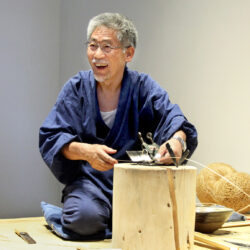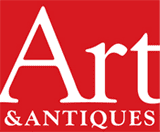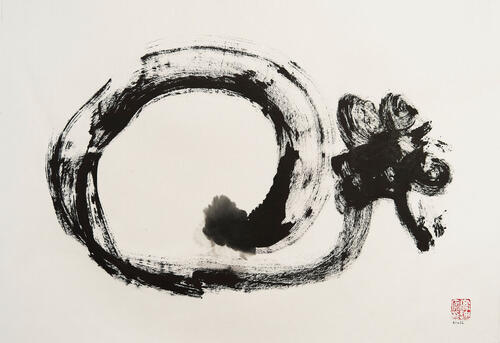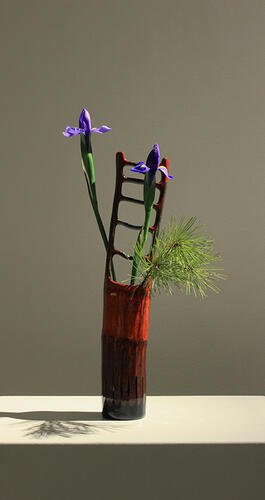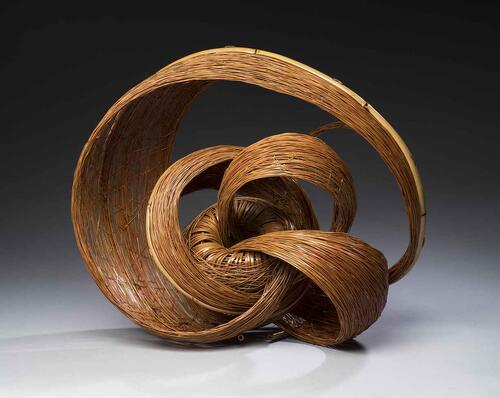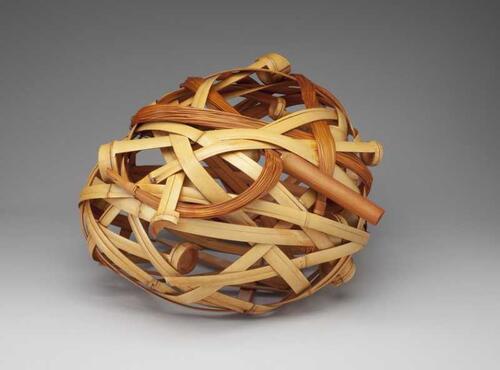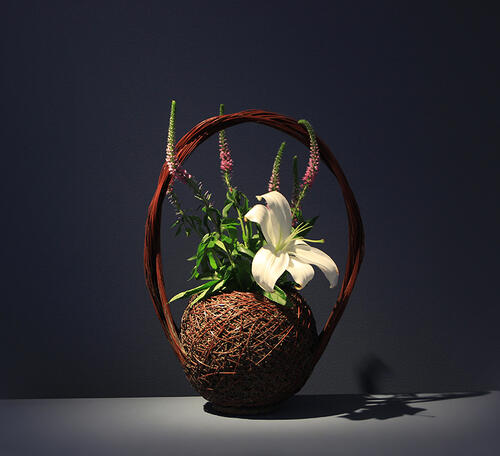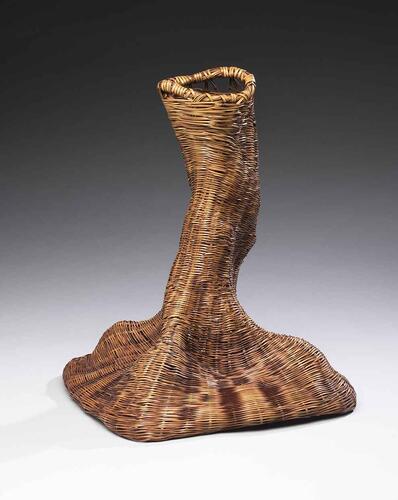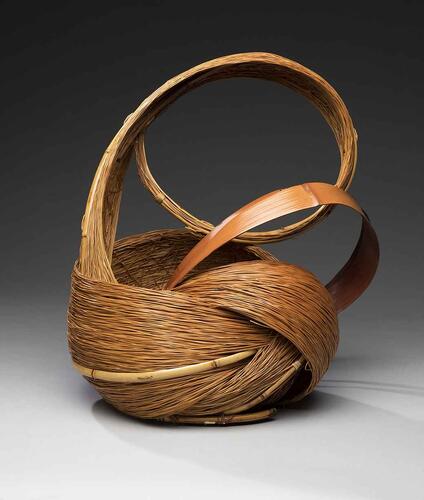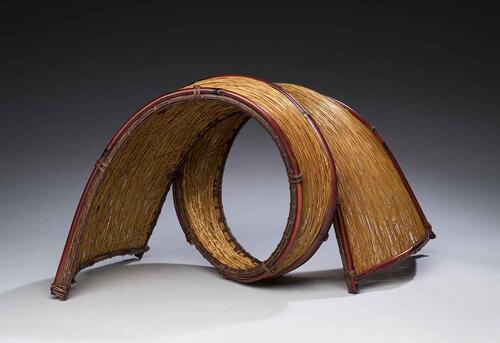If you don’t like art, don’t go to Santa Fe. You can’t avoid it, and that’s how the locals want it. It’s impossible to live among landscapes that practically scream, “Paint me!” without succumbing to the pull of gallery walks, museum exhibitions, studio demonstrations, art fairs, and more. The summer art scene in Santa Fe knows no bounds, spilling over into every aspect of city life, and that’s how it should be.
In May, the Georgia O’Keeffe Museum (217 Johnson Street) chose Cody Hartley as its fourth director, elevating him from the position of acting director. While he was careful not to tip his hand about his plans, Hartley says he hopes to make the visitor experience “more immersive” with techniques that “bring the landscape into the museum. When you drive through the landscape that inspired Georgia O’Keeffe, you have an epiphany—‘Oh, that’s why she was here.’ She captured the experience,” he says. “This is our way of breaking down the walls of the galleries.”
Recently, the museum installed Ritz Tower, a long, slim nightscape from O’Keeffe’s New York years, in Gallery 5, the space dedicated to that period of her life. “It’s an outstanding, singular example of her New York cityscapes, which is a really important, iconic subject matter in her career,” Hartley says. “She was discouraged from painting skyscrapers, and was [essentially] told to leave that to the boys. She was having none of that.” She painted it in 1928, the year before her first visit to New Mexico. “Ritz Tower is really the perfect transition painting, if you will, painting the city before she was inspired to paint the landscapes of New Mexico.”
On June 7, the museum unveiled the latest exhibition in its “Contemporary Voices” series—a show of works by the late Ken Price. He is the first deceased artist chosen for the series. The museum worked with Price’s family on selections for the exhibit, which pairs his ceramic sculptures and works on paper with O’Keeffe still lifes and landscapes. “Price was a remarkable colorist, an affinity I think he shared with Georgia O’Keeffe. And he was a master technician,” Hartley says, calling Price’s ceramics “innovative and demanding.” “Ken Price” is on view through October 23.
The New Mexico Museum of Art (107 West Palace) opened two exhibitions in the spring that will continue past Labor Day. “The Great Unknown: Artists at Glen Canyon and Lake Powell” (through September 15) examines the history of Glen Canyon, an area that spans southeastern Utah and northern Arizona and mostly disappeared beneath the Lake Powell reservoir after construction of the Glen Canyon Dam in 1966.
“Social & Sublime: Land, Place, and Art” (through November 17) delves into some of the issues but stands alone as an exhibition. The 38 artworks on view include pieces by Albert Bierstadt, Gustave Baumann, and Ansel Adams. “It’s a show about land and place, but it’s not a landscape show. Half the works are portraits, or images of people,” says curator Christian Waguespack. Raymond Jonson’s 1923 oil on canvas Earth Rhythms #2 doesn’t show human figures, but it does reflect a human vision of a landscape. “It’s about land and about New Mexico, but it’s really about experimenting with forms,” says Waguespack, explaining that Jonson painted it in Chicago after a trip to the southwestern state. “It has the visual language of the city of Chicago, but it’s about New Mexico, and he painted it when he was planning to come out here. There’s a lot of hope projected onto it.”
The intriguing “Paul Pletka: Converging Faiths in the New World” runs through October 20 at the Museum of Spanish Colonial Art (750 Camino Lejo). The first solo museum show in New Mexico of Pletka’s work since 1990, it features 15 paintings that incorporate images and iconography from Spanish Catholicism and depictions of gods by indigenous peoples from North and South America. These are displayed along with Mexican masks from the artist’s collection and items from the museum’s collection, which include a historic death cart.
OTA Contemporary (203 Canyon Road) will have several exhibitions on view this summer. “Beginnings III” combines 18 to 20 works by glass artist Wes Hunting with 10 sculptural, furniture-like pieces by Chad Manley. Staging the show posed a unique challenge to gallery founder Kiyomi Baird, who displayed some of Hunting’s glass on Manley’s surfaces. “What I tried to do is show the artwork not as it would look in a gallery or a museum, but where it’s integrated, so you feel when you walk in that it’s a total immersion,” she says. “It’s been a very successful exhibit.” Unlike more conventional displays that feature paintings on walls and sculptures on pedestals, “Beginnings III” requires a small restaging whenever a piece sells. “It keeps you on your toes,” Baird says. “It’s like a living exhibit, in a way. The basic composition is there, but tiny details will change.”
“The Magical World of Diane Price,” on view through July 31, features 6 to 8 mixed-media works that reflect a sense of magic and fun. An example is Bye Bye Birdie, a 2018 construction that resembles a wheeled pull toy and has a black bird perched upon it. “Price gives you a fun experience when you see it. It gives you joy,” she says. “That’s what I mean about the magic in it. The magic is when you envision a world that’s different from the way we see it after we grow up. It touches the part of all of us that remembers the imagination of a child.”
“Connections,” scheduled for August 2–October 27, combines the works of metal sculptors Robert Koch and Ivan McLean with those of Yoko Kubrick, who is new to the gallery and favors Carrara marble. Each will contribute 6 to 8 pieces. Those from Kubrick include Flora, a small 44-pound bud-like sculpture named for the Roman goddess of fertility and flowering plants. “They’re distinctly different in voice and form,” Baird says of the three artists. “Two work strictly in metal, which is very different from carving, which involves taking away material. There’s a nice tension.”
The end of summer brings “Spreading Happiness,” a solo show of 6 to 8 porcelain ceramics by Japanese artist Yuri Fukuoka, who is also new to the gallery roster. “Her whole idea when creating things is she wants to spread happiness. She believes if she makes things with joy and happiness, others will feel it,” Baird says, adding that the delicate, flower-like pieces must have made for unhappy days at the kiln. Fukuoka keeps her techniques to herself, according to Baird, who says the artist is “not ready to talk about” how she creates her ethereal porcelains: “It’s taken her a long time to figure it out. A lot of piles of mess. I’m sure she takes quite a while with these things.”
Eight bronzes by the late Native American artist Allan Houser appear in “Human Nature: Explorations in Bronze,” which opened in late spring and runs through May 10, 2020, at the Santa Fe Botanical Garden (SFBG). The powers that be at the SFBG chose a 1986 Houser limited edition, Watercarrier, as the logo for the show. The sculpture stands almost seven and half feet tall. “It’s at the entrance to the garden, where the guests come in to start tours,” says David Rettig, curator of collections for Allan Houser Inc., and states that it reflects the influence of Henry Moore, Barbara Hepworth, and Isamu Noguchi.
Not far from Watercarrier in the SFBG display stand two more Houser works, Dance of the Mountain Spirits I and II, both from 1989. Apache ceremonial dancers were a favorite subject of Houser, who was a Chiricahua Apache. “He did hundreds of paintings, if not thousands,” Rettig says. These sculptures represent one of Houser’s first forays into bronze with the theme. The Allan Houser Gallery (125 Lincoln Avenue, Suite 112) loaned the works to the year-long exhibition.
Nedra Matteucci Galleries (1075 Paseo de Peralta) launched its summer programming with “Chris Morel: One Man’s Home” on June 22, and will continue it through July 20. Morel, who has been with the gallery since 2010, created almost 30 watercolors and oils for the exhibition, with about a third of the works depicting scenes close to the artist’s longtime Northern New Mexico home. (Others show Colorado landscapes and vistas from Abiquiu, New Mexico.)
“Chris is able to capture the seasons beautifully. From snow-covered landscapes to yellow aspens, one can almost guess the season of each work,” says Dustin Belyeu, director of Nedra Matteucci Galleries. Luna Morning, an oil on linen painted in February that features a pearl-like moon at the upper right, is a perfect example of what Belyeu is talking about. “What I like most about Luna Morning is the contrast of light and shadow created by the diagonal bands of color,” he says. “I think his ability to use light, shadow, and the depth in the landscape created by this contrast, is what shows his mastery.”
“William Acheff: Small & Sacred” runs August 10–September 14 and features miniature paintings, measuring no larger than 10 by 12 inches. It’s a form Acheff, a trompe l’oeil specialist, knows well, having painted many petite works over the course of his career. He has produced more than 30 oils on panel for the show, including Sounds in Nature, a 9-by-7-inch work that focuses on a decorated flute and a color photograph of a Native American playing a flute. “The detail I am most drawn to is the cord wrapped around the flute,” Belyeu says. “That, to me, is the detail that most makes the work feel like you could reach out and pull the flute off the canvas.”
TAI Modern’s (1601 Paseo de Peralta) summer exhibitions begin with the gallery’s second solo show of works by Kibe Seiho (through July 13). The bamboo-weaving artist favors susutake, a form of bamboo that gains its color from decades upon decades’ worth of smoke rising from hearths built into the floors of Japanese farmhouses. “There’s definitely a shrinking supply of susutake. The dark, rich color can’t be achieved without 200 or 300 years of smoke,” says Steve Halvorsen, collections manager for the gallery. “When Seiho showcases it, he uses the finest quality.” The artist wove Blaze, a tapering cylindrical piece from 2017 that stands almost 15 inches tall, to revel in colors that range from pale beige to deep caramel.
Tanabe Chikuunsai IV’s eponymous show opens on July 26 and runs through August 24. The centerpiece will be a large site-specific bamboo installation at the gallery. The preparations “won’t start until a week or so before the opening,” Halvorsen says. “The bamboo is here, in crates. It’s pre-cut. He and three assistants get here in July and start work.” The installation won’t be for sale, but 25 more modestly sized bamboo pieces shown along with it will be.
On August 30, the gallery will open its first solo show of pieces by Monden Yuichi. It will feature about 15 works by the artist, whose 103-year-old father, Monden Kogyoku, showed with TAI Modern in 2010. Halvorsen contrasts them by describing the elder Monden’s vessels as closed while the son “makes sculptural pieces that challenge space a bit.” The exhibit closes on September 14.
LewAllen Galleries (1613 Paseo de Peralta) starts its summer with “Ben Aronson: Views from Above” (through July 20). It’s Aronson’s second solo show with the gallery, and it features 30 urban landscapes, some of which reference photographs shot with a drone-mounted camera. “He uses atmospheric qualities to create a sense of stillness in locations known for frenetic activity,” says Ken Marvel, co-owner and CEO of LewAllen Galleries. “His looser brush strokes vividly evoke the sense of place he endeavors to relate.”
“Dan Christensen: Stains and Loops” (through July 20) represents the gallery’s sixth or seventh solo show with the noted color abstractionist, who died in 2007. The 18 works on view come from three periods of his career: his Early Stain Paintings of 1976–84, his Late Stain Paintings of 2002–05, and his Last Loop Paintings, also his final series of paintings, done between 2004 and 2006. Torodoro, an acrylic on canvas that measures 58 by 99 inches, belongs to this last group. Christensen painted it when he was afflicted with polymyositis, an autoimmune and blood vessel disease that he could have contracted from spray-paint fumes and other toxins he exposed himself to in the course of his work. “Christensen never lost his respect and appreciation for the end result of Jackson Pollock’s art. These late Loops are a nod to the enduring respect and enthusiasm he had for authentic expression,” Marvel says. “Here, I think Dan was letting loose. He was conscious of his mortality and the seriousness of his disease and thought, ‘What the hell, I’ll give it what I’ve got.’ The energy and kinetic life is startling to see in person. If he couldn’t live in the world, he’d create paintings that would.”
“Wolf Kahn: Pastoral Reflections” begins on July 26 and finishes on August 24. The 30 works testify to the powers of an artist who has reached his 90s without losing a step. Marvel cites Pink Landscape, an oil on canvas from 2018, showing Kahn as “the master of the art of reductiveness” in his depiction of a wooded meadow suffused with the light of sunset or sunrise. “Rather than painting the colors in a literal replication, Wolf is grabbing the color that grabs him. It’s something we see more and more in his work.”
A show of Woody Gwyn works appears at the gallery over the same dates, and includes Ragged Point, an astonishing and impressively large (60-by-120-inch) egg tempera on panel. “He’s our exemplar of hyperrealism. He’s absolutely a genius. It took him four years to paint this thing, and it sold instantly. You can imagine why,” Marvel says. “It’s a breathtaking example of his capacity to take the ordinary and make it extraordinary.”
Gerald Peters Gallery’s (1005 Paseo de Peralta) summer offerings include “Reimagining New Mexico” (through August 3), which showcases the work of four artists: Leon Loughridge, Mike Glier, James McElhinney, and Don Stinson. Originally conceived as a solo show for Loughridge, it grew to include four gallery artists who happened to be exploring notions that fit the theme expressed by the show’s title. “We thought it could come together as a cohesive show,” says Evan Feldman, director of contemporary and estates for Gerald Peters Gallery Santa Fe. “Though very distinct ideas are happening, there are consistent threads we’re able to weave.”
Loughridge, the only one of the four who was born and raised in New Mexico, contributed between 15 and 18 works that meditate on iconic sites in the state. These include a 10-inch-by-40-inch serigraph of the ruins of Pueblo Bonito in Chaco Canyon. “One cannot read about Southwest history and not have read about Chaco Canyon and its importance to Southwestern culture. And for all the reading I had done, I was still overwhelmed at the scale and density of the structural site in the canyon,” Loughridge says. “I spent five days walking the area, from the close to the remote pueblo sites, and I felt I had barely begun to grasp the beauty of the site. Pueblo Bonito’s size and setting make it easy to visualize pilgrims arriving from throughout the southwest. Over 1,100 years have passed, and yet the Bonito Ruins are still impressive in their precise construction and size. Pueblo Bonito must have been truly awe-inspiring for the pilgrim that just trekked across miles of sage and sand.”
Glier offered about 20 pieces to the show, while Stinson contributed a dozen and McElhinney added 12 to 15. Glier tends to be looser and more impressionistic, while Stinson is often drawn to landscapes featuring wind turbines, abandoned signs, equipment, and other man-made objects. The last of the three, McElhinney, makes his Gerald Peters Gallery debut with this summer exhibition. Most of his pieces focus on the Rio Grande and other waterways, and most of their titles include precise dates. “He likes to do that in part because he works plein air and he was journaling a lot of the time,” Feldman says, noting that one of the artist’s 2-by-8-inch journals will be part of the display. “It was very important to him to capture the day. He’s interested in it as a record of his time and travel. From there, he creates a larger body of work.”
Charlotte Jackson Fine Art (554 South Guadalupe St.) marks three decades in the art world with “Celebrating 30 Years, Part I,” on view from July 5–30. Charles Arnoldi, Paul Sarkisian, and 13 other artists appear, each contributing at least one work. “I didn’t really think about it a whole lot until the fall of last year, when my assistant said, ‘Thirty years is a big deal. We should do something,’” says Charlotte Jackson, founder of the gallery. No artist on the roster has been with her for the entire span of time, though several have approached the two-decade mark. “These are artists I feel are almost like family,” Jackson says. “They’ve been really supportive of the gallery, and the gallery has been supportive of them.”
“Celebrating 30 Years, Part II” will take place from September 6–28. It will likely feature the same number of artists and works, but will spotlight the gallery’s early years and its firm focus on monochromatic art. “I know it sounds backward, but it makes more sense to put [the origins show] in September, when the collectors and artists can be with me.” Naturally enough, Part II will end with a party.
Pard Morrison’s first solo show with Charlotte Jackson, “Warp & Weft,” opens August 2 and continues through August 31. It will feature 10 to 15 pieces by the sculptor, whose multicolor works represent a clear but welcome shift from the gallery’s monochromatic roots. “He represents a bit of a change, but the forms feel comfortable with what we do here,” Jackson says. “They speak to the other paintings on the wall.” Morrison creates works such as Nimbus (2017), a 96-inch-tall aluminum column, by painting a color, firing the piece in a large kiln-like device, and repeating the process until all the colors are applied.
On July 5, Monroe Gallery of Photography (112 Don Gaspar) unveils “Living in History,” a show of images by contemporary photojournalists, including Ashley Gilbertson’s 2015 black-and-white of refugees disembarking on the Greek island of Lesvos, and Steve Schapiro’s 2018 shot of a Black Lives Matter protester. Photographers Nina Berman, Ryan Vizzions, and Rob Wilson are expected to appear at the July 5 opening reception. The show continues through September 22.
Pippin Contemporary (409 Canyon Road) will feature “Landscapes of the Mind,” a solo show by gallery founder Aleta Pippin, from July 5–17. Among the 15 works in the show is Awakening to the Light, a 2019 oil on canvas ablaze with color that measures 60 inches by 30 inches. “I do a lot of verticals. I like that shape,” says Pippin, who prefers palette knives to paint brushes. “I just start painting. I don’t have a plan. I paint until something starts to happen and I follow that.” The title of the show came first, and the works spring from memories of her initial encounter with the desert at the age of six. At first, the Michigan-born girl “thought I had gone to hell,” and her grandmother’s un-airconditioned car only worsened that first impression. “I was used to running around barefoot in the grass, but after a week or so, I loved it—the starless expansiveness of the rich blue sky was so different from what I was exposed to my whole life,” she says.
From July 24–August 7, the gallery features “Guilloume: Emergence.” It will be the Colombian sculptor’s seventh solo exhibition with the gallery. The 30 or so limited-edition bronzes, which will be displayed both inside the 3,600-square-foot gallery and outside in the 700-square-foot sculpture garden, depict women, many of them wearing hats. “The sculptures are faceless, so they can be any person. Anyone can look at them and put themselves in their place,” Pippin says.
Morning Star Gallery (513 Canyon Road) will offer “Artistry & Innovation – A Celebration of Pueblo Pottery” from August 5–September 2. Most of the ceramics in the exhibition were made by anonymous Native American women artisans between 1850 and 1920, and most come from a single collector, who wishes to remain anonymous. Gallery director Henry “Chick” Monahan has lavish praise for the man and his eye: “He really looked at each piece and bought it on its own merits,” he says. “He’s very discerning and picky. Everything is really well-painted.”
All 25 works in the show are water jars, and they represent 13 of the 20 pueblos of Arizona and New Mexico. Each can be linked to its place of origin by its temper—the material the potter added to the clay to prevent shrinkage and breakage in the kiln. Some used crushed rock, others sand, and still others pottery shards. “One of the most foolproof ways to figure out where a pot is from is its temper,” Monahan says. “Clays can look alike, but tempers are unique.”
The show provides a strong survey of the graphic styles of the various pueblos, but some pieces are unusual. Monahan singles out a circa-1860 water jar from Acoma Pueblo as an atypical example from a familiar place. “Typically, Acoma jars have some sort of hatching and fine line work. This jar is bold by Acoma standards, and this may be only the second known example with the unpainted arcs on the base of the jar,” he says. “It’s really beautiful and unusual.”
On August 30, Gallery 901 (555 Canyon Road) will open “Reflections from Russia,” a retrospective of the work of the late Fedor Zakharov, the leading Russian plein air landscape painter of the Soviet era. The show, which runs through September 20, will feature between 15 and 20 landscapes of Crimea and Ukraine, most of which Zakharov created between the 1960s and the 1990s. Nine of the works have never appeared in the United States and have not been publicly shown since his death in 1994. In a Good Mood (1980) reflects politics in an unexpected way. The artist’s distaste for the Soviet regime led him to spurn the dull, earth-tone Soviet-produced paints. His brighter palette imbues the work with a sense of happiness and positivity not often seen in Soviet canvases.
The 16th annual International Folk Art Market graces Museum Hill in Santa Fe from July 12–July 14. Artists from 50 countries will appear at this celebration of master folk artists, and three countries—Bulgaria, Iraq, and Australia—will be represented for the first time. Bulgarian woodcarver Ivan Dimitrov contributes elaborate carvings fashioned with chisels and mallets; Salma Abed Damej appears on behalf of Nature Iraq, a nonprofit that supports female weavers in the south of the country; and Australian aboriginal artist Janet Golder Kngwarreye, a member of the Clare Valley Art Collective, offers spellbinding abstract paintings that meditate on her heritage.
The 19-year-old fair Art Santa Fe returns to the Santa Fe Convention Center July 18–21. Its chosen curatorial theme is “momentum,” which describes and represents the strength of the artists and galleries that the fair represents. More than 60 galleries from across the U.S. and the world will attend.
Mexican artist Ricardo Cárdenas-Eddy might be an odd match for the theme, given that his preferred medium is recycled concrete and other building materials that aren’t easily moved. Cárdenas-Eddy unquestionably has momentum in the context of the fair, however. He will debut new works in the booth of Contemporary Art Projects (CAP), a Miami gallery, including Tribute to Jean Michel and Andy, a collection of nine concrete blocks featuring the faces of Basquiat and Warhol overlaid with the circles and crosses of a game of tic-tac-toe. Cárdenas-Eddy also features in one of the fair’s Art Labs presentations. It showcases La Pared de Frida, an image of Frida Kahlo fashioned from cement and reinforced with steel bars.
Performance artist Max Robert Daily provides the other Art Lab presentation, and it’s definitely out of the ordinary. Oslo Sardine Bar originated with an adventure Daily had aboard a Danish freighter. The ship broke down at sea, leaving the crew with little to do. The artist ransacked the emergency food supply, contributed bottles of Czech rum from his own stash, set up a backgammon board and a record player, and created a tiny makeshift bar. Daily replicates the spontaneity of the moment with the installation. “You come into this special room—it’s really a crate he has created, and you’re in the art experience,” says Linda Mariano, managing director of marketing for the Redwood Media Group, which produces Art Santa Fe. “You sit. The artist is at the bar. He’s the proprietor. He offers you a sardine on a saltine cracker. You see his sardine bar artwork, and you leave with a newspaper boat hat. It’s an experience as much as an art installation. It’s really fun.” Art & Antiques is a media partner of the fair.
Art Santa Fe will bookend the back half of Santa Fe Art Week, a new endeavor that runs from July 12–21. Designed to celebrate and boost the city’s art scene, Santa Fe Art Week encompasses more than 100 shows and activities by artists, studios, galleries, collectors, and museums.
The Objects of Art Santa Fe show takes place at El Museo Cultural de Santa Fe (555 Camino de la Familia) from August 9–11. More than 70 exhibitors will appear, including Los Angeles gallery Powers Fine Arts, San Diego gallery Oriental Treasure Box, and Santa Fe dealer Randall Bell, all of whom are new to the fair.
This year’s special exhibition, “The Creative World of Alexander Girard,” focuses on the prominent fabric designer’s years in Santa Fe. “Girard was terribly thorough about overall design projects. He was a complete designer,” says John Morris, co-producer of Objects of Art Santa Fe, who points out that Girard shaped the look of The Compound Restaurant, a Canyon Road establishment that still appears largely as Girard designed it in 1966. Only some of the pieces on view will be for sale.
Once Objects of Art Santa Fe concludes, Morris and co-producer Kim Martindale will install the Antique American Indian Art Show in the same venue from August 14–16. More than 50 galleries and dealers will appear at the fair, which will feature a special exhibition titled “Tradition and Innovation: The Legacy of Julian Lovato.” It will be the first major show of the Native American jeweler’s works in Santa Fe, and the first since his death last year. About 80 percent of the works on view will be for sale. “He brought forward a contemporary feel, with cleaner, bolder lines, but he kept the strength of the traditions,” Martindale says. “He was a link to the past and a link to the future.”
The 68th annual Traditional Spanish Market, offered by the Spanish Colonial Arts Society, takes place on the Santa Fe Plaza from July 27–28. A market preview event will happen on the 26th at El Museo Cultural de Santa Fe (555 Camino de la Familia). Weavings, jewelry, pottery, colcha embroidery, tinwork, ironwork, woodcarving, and other arts and crafts will be on offer at the event, which will be attended by more than 200 artists from New Mexico and southern Colorado. The market will serve as the capstone of ¡Viva la Cultura!, a weeklong slate of Santa Fe events that kicks off on July 22 and includes concerts, studio tours, artist demonstrations, lectures, and regional foods.
The Santa Fe Art Auction will hold an online sale of Western Arts and Objects from August 16–25. It will offer between 100 and 150 lots of textiles, pottery, beadwork, bronzes, and other works. The annual live Santa Fe Art Auction (1011 Paseo de Peralta) will take place on November 9. It will include choice pieces from the 330-strong collection of the late Patricia Janis Broder, a pioneering collector of Western and Native American art and author of art-history books on those topics. The organizers of the auction were getting calls as early as May asking if the consignment included works by Native American artist Oscar Howe. Indeed, the November sale will include Medicine Man, an undated casein on paper estimated at $25,000–35,000. Though Howe had a long career, his work has appeared at auction just four times to date. Gillian Blitch, executive director of the auction, said that getting calls about a specific piece six months before a sale is extraordinary but understandable in this case. “It’s so rare to get an Oscar Howe to come on the market,” she says. “It’s a strong example from him, and it’s really remarkable.”
Works from all five members of the Artist Hopid group are in the November lineup, including Milland Lomakema’s striking 1975 acrylic on canvas Corn Maidens, estimated at $5,000–10,000. The sale will also feature a version of R.C. Gorman’s bronze Natoma on a wooden base. The 46-inch-tall image of a barefoot Native American dancer, whose upturned chin calls to mind Degas’ famous bronze of a young ballerina, carries an estimate of $10,000–15,000.
The 98th Santa Fe Summer Indian Market, the largest and most prestigious juried Native arts show on the planet, takes place on the Santa Fe Plaza August 17–18. Produced by the Southwestern Association for Indian Arts (SWAIA), it will feature about 1,000 artists from more than 200 native tribes across the United States and Canada. On August 16, the Institute of American Indian Arts (IAIA) will hold a best-of-show ceremony and luncheon at the Santa Fe Community Convention Center (201 W. Marcy Street), followed by previews of the award-winning pieces. The 2018 Best of Show award went to Kevin Pourier, an Oglala Lakota artist from Pine Ridge, S.D., who triumphed with Winyan Wánakiksin, a belt depicting Native women protesters. Each portrait on the belt took Pourier about two weeks to finish. The National Museum of the American Indian at the Smithsonian purchased it.
—
Sheila Gibson Stoodley is a journalist and the author of The Hot Bid (thehotbid.com), which features intriguing lots coming up at auction.

